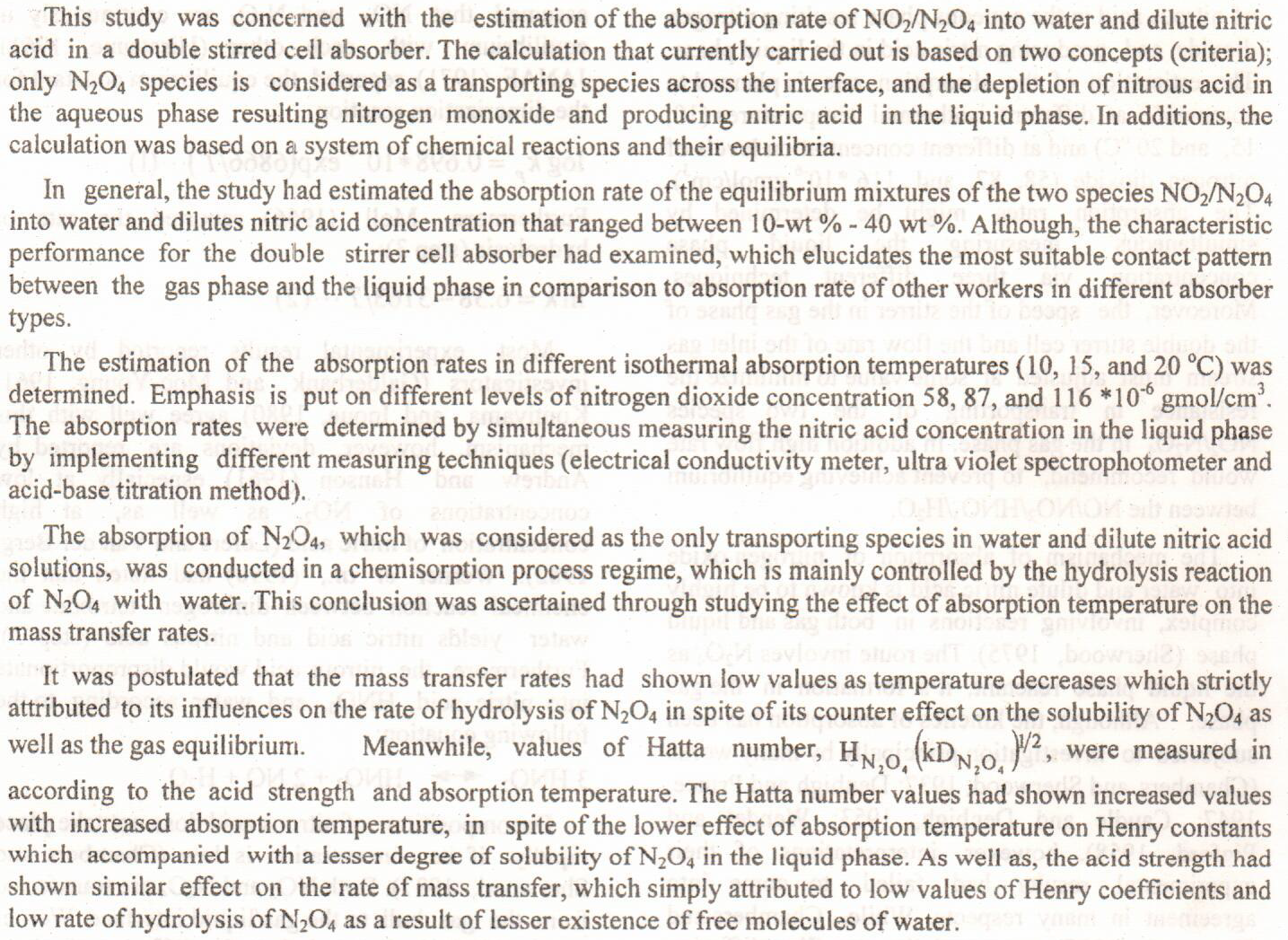
The remove of direct blue (DB71) anionic dye on flint clay in aqueous solution was investigated by using a batch system for various dye concentrations. The contact time, pH, adsorbent dose, and temperature was studied under batch adsorption technique. The data of adsorption equilibrium fit with isotherm Langmuar and Freiundlich ,when the correlation coefficient used to elucidate the best fitting isotherm model. The thermodynamic parameters such as, ?Hº ,?Sº and ?Gº. Thermodynamic analysis indicated that the sorption of the dyes onto Flint clay was endothermic and spontaneous.
The present study utilised date palm fibre (DPF) waste residues to adsorb Congo red (CR) dye from aqueous solutions. The features of the adsorbent, such as its surface shape, pore size, and chemical properties, were assessed with X-ray diffraction (XRD), BET, Fourier-transform infrared (FTIR), X-ray fluorescence (XRF), and field emission scanning electron microscope (FESEM). The current study employed the batch system to investigate the ideal pH to adsorb the CR dye and found that acidic pH decolourised the dye best. Extending the dye-DPF waste mixing period at 25°C reportedly removed more dye. Consequently, the influence of the starting dye and DPF waste quantity on dye removal was explored in this study. At 5 g/L dye concentration, 48% d
... Show More (9)
(9)
 (6)
(6)
Removal of Congo red, Rhodamine B, and Dispers Blue dyes from water solution have been achieved using Flint Clay as an adsorbent. The adsorption was studied as a function of contact time, adsorbent dose, pH, and temperature under batch adsorption technique. The equilibrium data fit with Langmuir, Freundlich and Toth models of adsorption and the linear regression coefficient R2 was used to elucidate the best fitting isotherm model. Different thermodynamic parameters, namely Gibb’s free energy, enthalpy and entropy of the on-going adsorption process have also been evaluated. Batch technique has been employed for the kinetic measurements and the adsorption of the three dyes follows a second order rate kinetics. The kinetic investigations al
... Show More (1)
(1)
In this study, a new adsorbent derived from sunflower husk powder and coated in CuO nanoparticles (CSFH) was investigated to evaluate the simultaneous adsorption of Levofloxacin (LEV), Meropenem (MER), and Tetracycline (TEC) from an aqueous solution. Significant improvements in the adsorption capacity of the sunflower husk were identified after the powder particles had been coated in CuO nanoparticles. Kinetic data were correlated using a pseudo-second-order model, and was successful for the three antibiotics. Moreover, high compatibility was identified between the LEV, MER, and TEC, isotherm data, and the Langmuir model, which produced a better fit to suit the isotherm curves. In addition, the spontaneous and exothermic nature of the adso
... Show More (25)
(25)
In the present study, activated carbon supported metal oxides was prepared for thiophene removal from model fuel (Thiophene in n-hexane) using adsorptive desulfurization technique. Commercial activated carbon was loaded individually with copper oxide in the form of Cu2O/AC. A comparison of the kinetic and isotherm models of the sorption of thiophene from model fuel was made at different operating conditions including adsorbent dose, initial thiophene concentration and contact time. Various adsorption rate constants and isotherm parameters were calculated. Results indicated that the desulfurization was enhanced when copper was loaded onto activated carbon surface. The highest desulfurization percent for Cu2O/AC and o
... Show MoreIn this study, a new adsorbent derived from sunflower husk powder and coated in CuO nanoparticles (CSFH) was investigated to evaluate the simultaneous adsorption of Levofloxacin (LEV), Meropenem (MER), and Tetracycline (TEC) from an aqueous solution. Significant improvements in the adsorption capacity of the sunflower husk were identified after the powder particles had been coated in CuO nanoparticles. Kinetic data were correlated using a pseudo-second-order model, and was successful for the three antibiotics. Moreover, high compatibility was identified between the LEV, MER, and TEC, isotherm data, and the Langmuir model, which produced a better fit to suit the isotherm curves. In addition, the spontaneous and exothermic nature of the adsor
... Show More (29)
(29)
 (25)
(25)
Tow simple, rapid and sensitive spectrophotometric methods for the determination of mesalazine in pharmaceutical preparations have been carried out. The proposed methods depend on oxidative coupling reaction of mesalazine with m-aminophenol in the existence of N-bromosuccinamide in alkaline medium (method A) and 2,6-dihydroxybenzoic acid in the existence of sodium metaperiodate in basic medium (method B) to produce colored products , show highest absorptions at 640 (nm) and 515 (nm), alternately. Beer’s law was consistent in concentrations extent of 1.25-30 and 0.5-12.5 (µg.mL-1) with molar absorptivity of 0.36×104 and 0.77×104 L.mol-1.cm<
... Show More (5)
(5)
 (3)
(3)
Background: For decades, the use of naturally accessible materials in treating human disease has been widespread. The goal of this study was to determine the anti-fungal effectiveness /of the lemongrass essential oil (LGEO) versus Candida albicans (C. albicans) adhesion to polymethylmethacrylate (PMMA) materials. Material and methods: LGEO's anti-fungal activity was tested against C. albicans adhesion using the following concentration of LGEO in PMMA monomer (2.5 vol. %, 5 vol. % LGEO) selected from the pilot study as the best two effective concentrations. A total of 40 specimens were fabricated for the candida adherence test and were subdivided into four equal groups: negative control 0 vol. % addition, experimental with 2.5 vol. % and
... Show More (6)
(6)
 (1)
(1)
Background: Adipose derived-mesenchymal stem cells have been used as an alternative to bone marrow cells in this study. Objective: We investigated the in vitro isolation, identification, and differentiation of stem cells into neuron cells, in order to produce neuron cells via cell culture, which would be useful in nerve injury treatment. Method: Mouse adipose mesenchymal stem cells were dissected from the abdominal subcutaneous region. Neural differentiation was induced using β-mercaptoethanol. This study included two different neural stage markers, i.e. nestin and neurofilament light-chain, to detect immature and mature neurons, respectively. Results: The immunocytochemistry results showed that the use of β-mercaptoethanol resulted in
... Show More (4)
(4)
